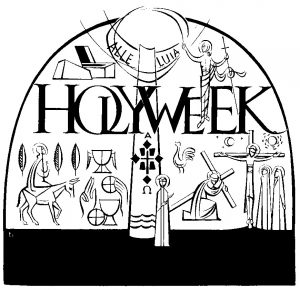
Holy Thursday, April 6
Worship 7:00 pm
Good Friday, April 7
Tenebrae Service 7:00 pm
Easter Sunday, April 9
Worship 9:30 am
Easter Egg Hunt Following Service
Easter Breakfast Following Easter Egg Hunt
An Explanation of Holy Week Worship:
The three services of Holy Week: Holy Thursday, Good Friday, and Easter Sunday, are the climax of the church year. Throughout the centuries, these three services were viewed as one continuous service that began on Maundy Thursday and ended on Easter called the Triduum
Part I. Holy Thursday
The theme of Holy Thursday is best expressed by the Gospel of John as Jesus gives the novum mandatum or “new command” that his disciples “love one another.” The institution of the Lord’s Supper sets forth the depth of Jesus’ love and gives power to the Church to live out his command. Holy Thursday marks the end of Lent proper and begins the Triduum. At the conclusion of the Holy Thursday worship service, the altar is stripped and the candles. This symbolizes the abandonment of Jesus in the Garden of Gethsemane. It also prepares the worshipper for the continuing of the Triduum on Good Friday.
Part II. Good Friday
Good Friday’s worship is the middle portion of the Triduum. Good Friday is not a “funeral” for Jesus, but an austere celebration of the Lamb and his sacrifice. On this evening we use a service of darkness known as a Tenebrae service. This service centers on a series of lessons and psalms which, together with hymns, reflect on the Lord’s crucifixion and our repentance. As the service progresses a sevenfold candelabrum is extinguished, one candle at a time, until only one candle remains. That candle is removed from the chancel, leaving the sanctuary in darkness. The service is closed by a loud noise called a strepitus. It foreshadows the rending of Christ’s tomb on Easter. After the strepitus the solitary candle is returned to the sanctuary, anticipating the lighting of the paschal candle Easter morning. As on Maundy Thursday, there is no blessing at the end of the service.
Part III. Easter Sunday
Easter morning is the climax to the Triduum. Upon arriving in the sanctuary the worshipper sees that the paschal candle is lit, representing the resurrected Christ. The service begins with the joyous cry “Christ is risen!” to which the congregation responds, “He is risen indeed!” The entire Easter morning service is a celebration of Christ’s victory over sin and death and the power of the devil. That joy climaxes as the worshipper receives once again the blessing of the Lord at the conclusion of the service. The joy of Easter then continues throughout the rest of the church year.

